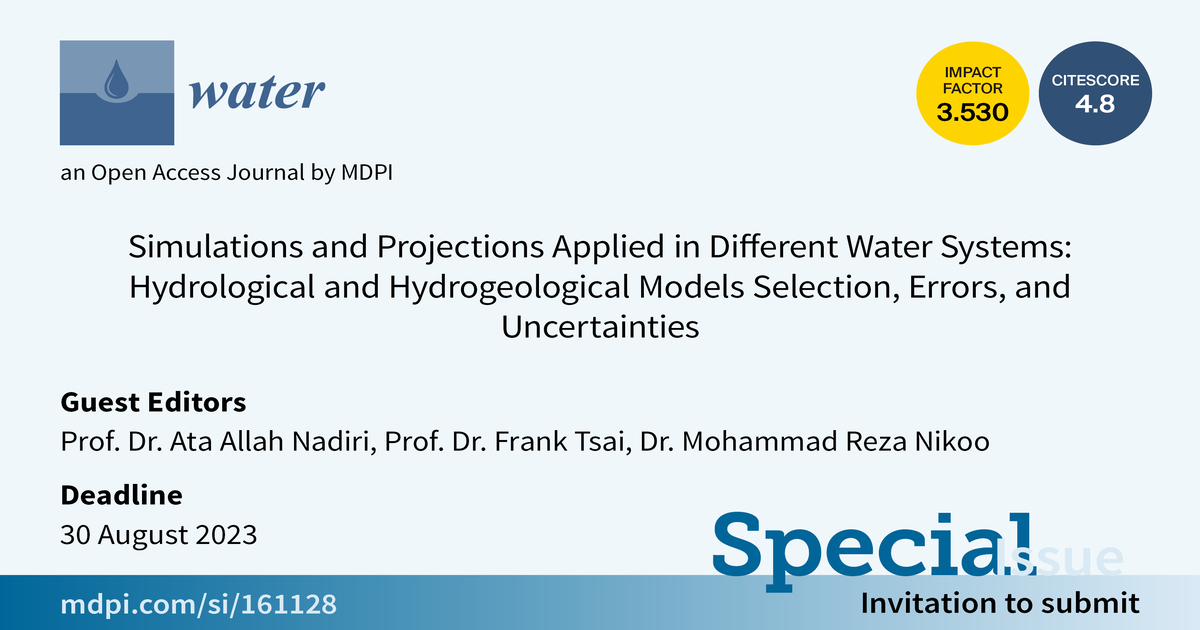Simulations and Projections Applied in Different Water Systems: Hydrological and Hydrogeological Models Selection, Errors, and Uncertainties
A special issue of Water (ISSN 2073-4441). This special issue belongs to the section "Hydrology".
Deadline for manuscript submissions: closed (30 August 2023) | Viewed by 2120

Special Issue Editors
Interests: numerical and AI modelling; water quality, groundwater vulnerability; risk analysis and assessment; multiple model discipline; uncertainty
Interests: groundwater; hydrogeology; surface and groundwater interactions; subsurface characterization; riverbank seepage; uncertainty analysis
Special Issues, Collections and Topics in MDPI journals
Interests: machine learning and data science; reservoirs; groundwater and river and water quality modeling; application of remote sensing (RS) in water resources and environmental management; water quality monitoring and water resources systems analysis and planning; optimization and simulation techniques and water quality assessment; integration with numerical, hydrological and climate change models for different water resource and water quality assessments; floods; seawater intrusion; costal management
Special Issues, Collections and Topics in MDPI journals
Special Issue Information
Dear Colleagues,
In recent decades, various numerical and artificial intelligence codes have been adopted to simulate, calibrate, and predict hydrological and hydrogeological systems. Several models may lead to the same or similar results for each water system, and the main problem is selecting the superior model (single model) or using the multiple model discipline between them. The error of the model results and uncertainty of the input data, within and between models, are the main criteria for model evaluation.
Different approaches are applied to select a superior model or use multiple models (MMs) to generate optimal results from numerical and artificial intelligence models in different water systems, such as the prediction of runoff, rainfall, groundwater level, water contaminants and estimation of groundwater vulnerability and risk, land subsidence and so on. The main challenge is to determine whether single or multiple models are preferred for the simulation/projection of water systems. This Special Issue focuses on these approaches in hydrological and hydrogeological sciences, as follows:
- Estimation of the uncertainty of artificial intelligence and numerical models;
- Different approaches for efficiency evaluation of artificial intelligence and numerical models;
- Superior model selection approaches for artificial intelligence and numerical models;
- Different approaches for aggregate models or generating multiple models (MMs) of the artificial intelligence and numerical models;
- Comparison of advantages and disadvantages of multiple models and superior models.
Prof. Dr. Ata Allah Nadiri
Prof. Dr. Frank Tsai
Dr. Mohammad Reza Nikoo
Guest Editors
Manuscript Submission Information
Manuscripts should be submitted online at www.mdpi.com by registering and logging in to this website. Once you are registered, click here to go to the submission form. Manuscripts can be submitted until the deadline. All submissions that pass pre-check are peer-reviewed. Accepted papers will be published continuously in the journal (as soon as accepted) and will be listed together on the special issue website. Research articles, review articles as well as short communications are invited. For planned papers, a title and short abstract (about 100 words) can be sent to the Editorial Office for announcement on this website.
Submitted manuscripts should not have been published previously, nor be under consideration for publication elsewhere (except conference proceedings papers). All manuscripts are thoroughly refereed through a single-blind peer-review process. A guide for authors and other relevant information for submission of manuscripts is available on the Instructions for Authors page. Water is an international peer-reviewed open access semimonthly journal published by MDPI.
Please visit the Instructions for Authors page before submitting a manuscript. The Article Processing Charge (APC) for publication in this open access journal is 2600 CHF (Swiss Francs). Submitted papers should be well formatted and use good English. Authors may use MDPI's English editing service prior to publication or during author revisions.
Keywords
- inverse problems
- numerical models
- artificial intelligence
- machine learning
- uncertainty analysis
- single models
- multiple models
- groundwater hydraulics
- water quality
- groundwater vulnerability and risk
- land subsidence
- rainfall–run off models
Benefits of Publishing in a Special Issue
- Ease of navigation: Grouping papers by topic helps scholars navigate broad scope journals more efficiently.
- Greater discoverability: Special Issues support the reach and impact of scientific research. Articles in Special Issues are more discoverable and cited more frequently.
- Expansion of research network: Special Issues facilitate connections among authors, fostering scientific collaborations.
- External promotion: Articles in Special Issues are often promoted through the journal's social media, increasing their visibility.
- Reprint: MDPI Books provides the opportunity to republish successful Special Issues in book format, both online and in print.
Further information on MDPI's Special Issue policies can be found here.







